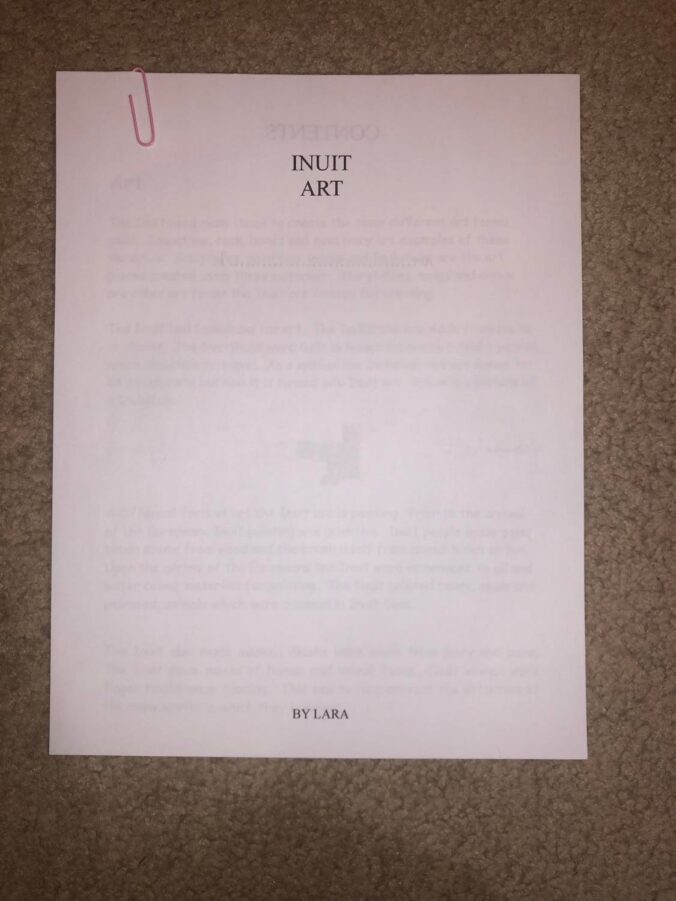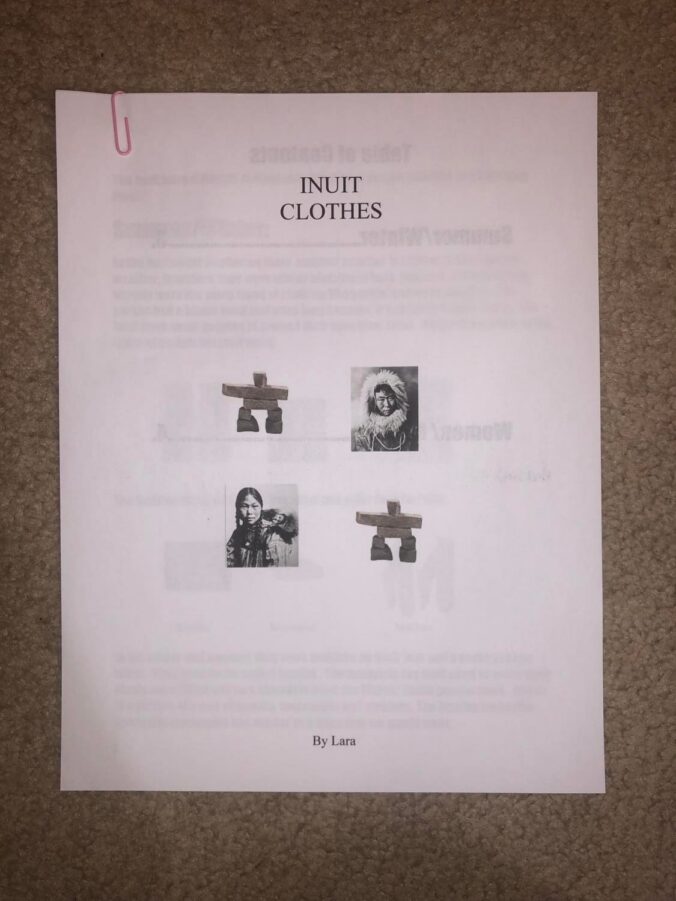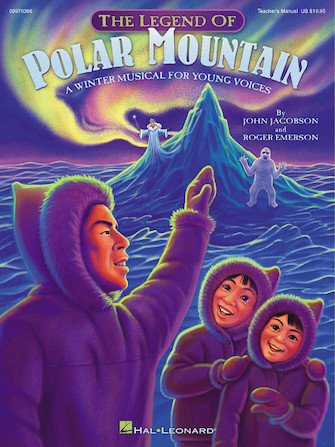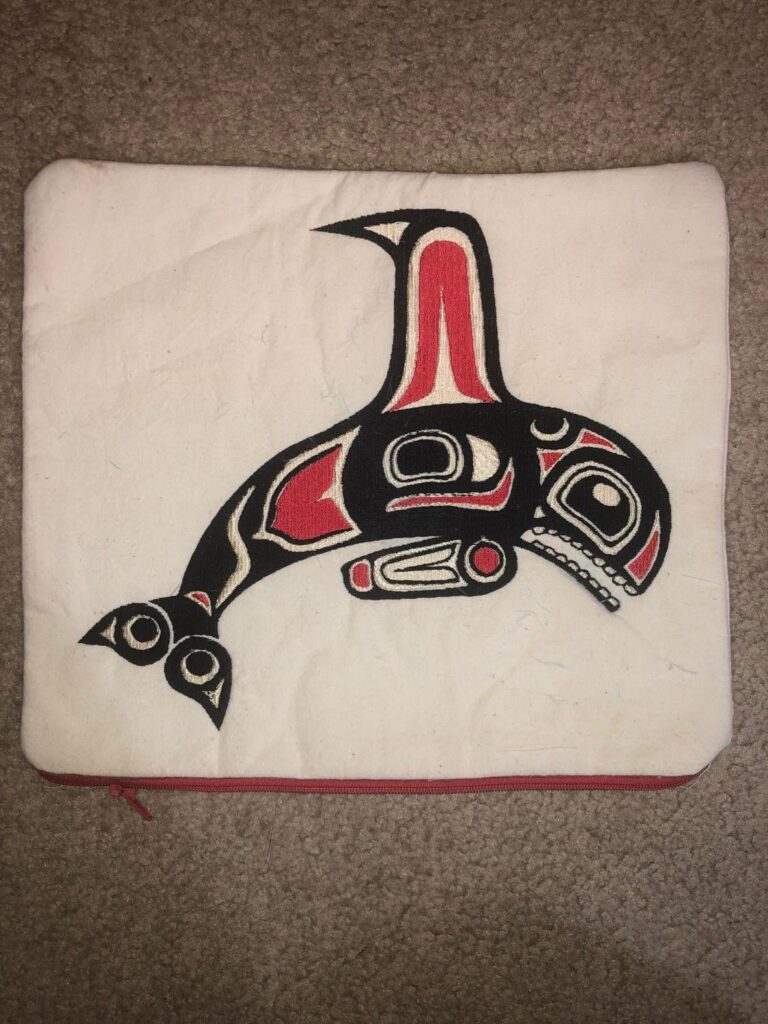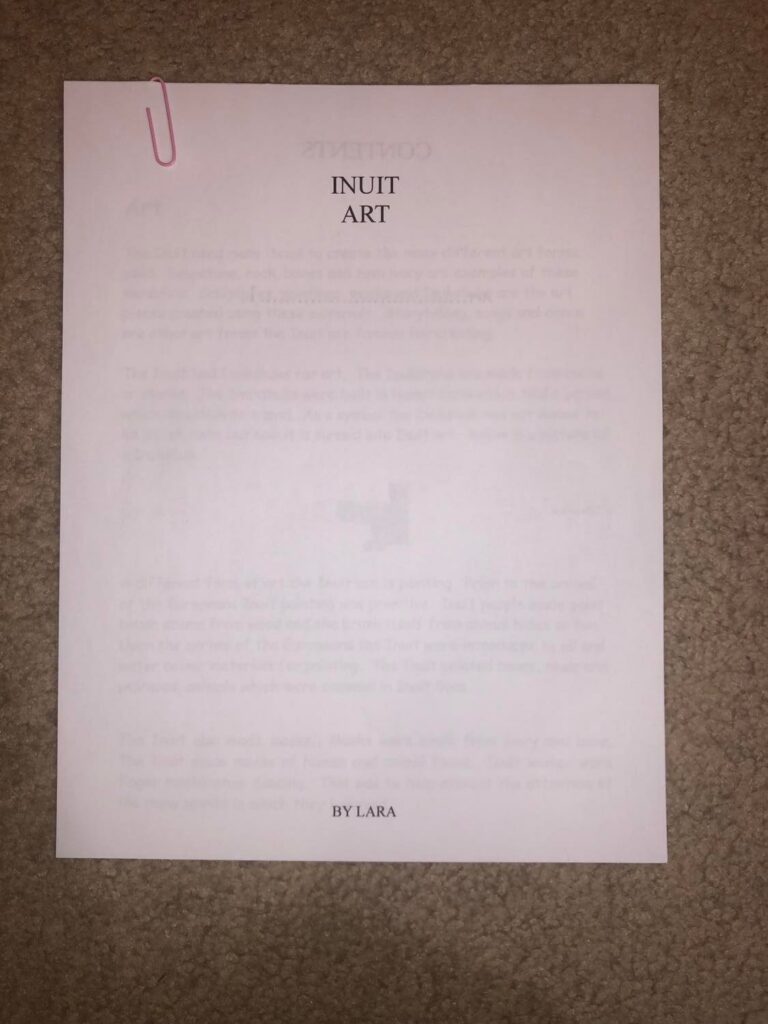What is cultural appropriation and appreciation? Is there an appropriate way to bring culture into the classroom? How do my old assignments line up?
Day: 1 December 2021 (Page 1 of 2)
In the picture above, I was in the third grade, and I had just finished making an Inukshuk for one of my assignments with my dad.
I am not sure whether this assignment would be considered cultural appropriation. Looking back, I realize that I appear white and was making something that generations of my people had decimated and hated. However, before making the Inukshuk, I took the time to write the Inuit art report and learned the information on how the art was used and made. I then went with my dad to make the Inukshuk. If intent counts, which it might not, I was trying to respect the Inuit people by recreating their art that I found interesting. I did not do it to be cool or trendy, but to learn more about the process of creating an Inukshuk and deepen my understanding of Inuit art.
To shift consciousness using one of Gorski (2008)’s steps, I would use “shift no. 6: ‘neutrality’ = status quo” (Gorski, 2008). I am still not sure whether this project counts as cultural appropriation; however, if I am still on the fence, I can assume something about it is not right. By actively becoming unneutral towards this, I am trying to acknowledge the power I hold as a white Canadian and decolonize this project.
Gorski, P. C. (2008). Good intentions are not enough: A decolonizing intercultural education. Intercultural Education, 19(6), 515–525. https://doi.org/10.1080/14675980802568319
In this assignment, we had to create a report or project on Inuit art. I decided to create a report which highlighted different Inuit art styles and materials. However, I remember that when we presented our projects, someone in my class had made a seal out of soap stone. I believe this is still not cultural appropriation since the student had followed the carving steps and made a report on the different meanings in Inuit art. She researched the history in the designs and picked one based off what she had learned.
As for my assignment, I also do not think it is cultural appropriation since it discusses the types of Inuit art and the purposes of them. It also goes into detail on how materials were chosen for the artwork before the Europeans settled.
When I was in grade three, we had to make a report on Inuit clothing. Students could represent their learning however they saw fit, but I decided to write a report.
I believe that this assignment is cultural appreciation since students were looking into the culture and seeing what they wear and why they wear it. The paper investigates what the women and men were wearing and talked about how they dressed in the summer vs. the winter. In the paper, the clothing is owned by the Inuit people and the students are looking into the history of why they wore the clothing depending on the location.
Although this project was not in elementary or middle school but in grade 10, I still thought it was a good way to include culture in the classroom. Within this project, students needed to dive into their heritage and look at their culture by mapping their family and interviewing their family members. If students did not feel comfortable mapping their own heritage, they could look at a culture throughout Canada’s history.
I believe that this project increases cultural appreciation within the classroom since it has students looking into their own culture and asking their family members for their own experiences. There is not one race that has more power over the other since students are looking into their own history and what makes them unique. If students were to choose to trace a culture through Canada’s history, I still do not believe that it would be cultural appreciation since students would be looking at the history and the oppression or relationships between the culture and the European Settlers.
When I was in grade three, I did weekly assignments on the Haida people and explorers. For some assignments, we were told to follow a topic. I made this bag to demonstrate Haida art physically.
I believe that this bag is considered cultural appropriation. The bag has nothing to do with Haida culture other than the whale embroidered on the front. Since this was a guided inquiry, the class did not dive into the symbolism in the designs but the materials used and the resources they had. Not only that, but as a white person taking their design without regard to the Indian Act, which banned Indigenous culture and then bringing it into class as an assignment without knowing the meaning behind the art furthers the oppression and racism that went on and continues to go on.
To make this assignment more appreciative, I would have students learn more about the design and meaning behind the whale. I would also want students to research how the Haida people designed and painted their art and have the students try it the same way. This way, I can ensure we are making the art the intended way, and students will learn the history and understand more about their culture.
To shift consciousness using one of Gorski (2008)’s steps, I would use “shift no. 1: cultural awareness is not enough” (Gorski, 2008). When I was making the bag, I was aware of Haida culture and artwork and knew that they had whales in their art since they lived near the water; however, it is not enough to know about it. The student needs to understand the history and oppression as well as the power in play. By recreating the art, I was taking credit for the design and contributing to the oppression that Haida people face when trying to get their art seen and recognized.
Gorski, P. C. (2008). Good intentions are not enough: A decolonizing intercultural education. Intercultural Education, 19(6), 515–525. https://doi.org/10.1080/14675980802568319
Although this project is not from elementary or middle school, I still thought it would be a good addition to show what cultural appropriation can look like. In this project, we needed to create a skull from clay and decorate it in the style of Dias De Los Muertos.
I believe this project is cultural appropriation since we did not learn about the culture or traditions behind Dias De Los Muertos and just took the designs and ideas from their sugar skulls into our artwork. The teacher created worksheets and papers to help practice painting when working on the assignment, which did not deepen our learning on the holiday or Mexican culture. We were told that it was like Halloween since they happened at the same time of year. Additionally, we were not taking traditional Mexican culture and appreciating the tradition that has been done for years, but we were creating our own design, which did not align with the history of the skulls. We were doing it to make cool art pieces rather than appreciate the holiday and celebrations.
To make this art project more appreciative, I would have students investigate the holiday’s history and understand the meaning behind the designs and appearances. In addition, I would try to incorporate Mexican knowledge into the holiday. Finally, if we were allowed to recreate some of their traditional designs, I would try and have students incorporate them into their art pieces and learn its history.
To shift consciousness using one of Gorski (2008) ’s steps, I would use “shift no. 1: cultural awareness is not enough” (Gorski, 2008). When the teacher introduced the project, she was very passionate about incorporating Mexican culture into the class. However, just because you bring awareness of culture into the classroom does not mean the culture is not being appropriated. The teacher and her students were still white and held power over Mexican culture; by bringing this assignment into the classroom, we are not committing to social justice instead of contributing to the oppressive norm (Gorski, 2008).
Gorski, P. C. (2008). Good intentions are not enough: A decolonizing intercultural education. Intercultural Education, 19(6), 515–525. https://doi.org/10.1080/14675980802568319
In 2010, my elementary school put on the winter play called The Legend of Polar Mountain. In the play, two Inuit siblings get lost on Polar Mountain; while they are looking for a way home, they run into a moose, beaver, snow queen, and snow monster!
I believe this play is cultural appropriation since the main characters in the play are Inuit; however, it does not add to the story. It appears the writers added Inuit culture since they wanted to make it more diverse. There is no respect for Inuit people in the play since Inuit culture and traditions are not mentioned. Instead, there is a strong sense of nationalism for Canada since different Canadian stereotypes are mentioned throughout the play, overlooking the Inuit storyline. Additionally, the play’s themes lean towards Christmas and goodwill towards men, overlooking the Catholic church’s impact on the oppression of Indigenous people in Canada. While rehearsing the play, we did not learn anything about Indigenous culture other than elders tell stories to pass down information from generation to generation.
I do not think there is a way to appreciate Inuit culture within this play. However, if I were to go back to 2010 and recommend something, I would encourage the students to learn about Indigenous culture and history with European settlers. This play could be used critically as a resource to teach stereotypes and nationalism, but I do not think it should be performed for an audience.
To shift the consciousness using one of Gorski (2008) ’s steps, I would use “shift no. 2: justice first, then conflict resolution” (Gorski, 2008). I would use shift two since the appropriation is so obvious in this assignment that it needs to be called out immediately. The writers use this play to portray stereotypes and pass it off as culture, and I do not think it can continue to happen and be performed. As a teacher, if this were being performed at my school, I would ensure the faculty knows the difference between cultural appropriation and appreciation and insist they choose a different play. I could also use “shift no. 6: ‘neutrality’= status quo” (Gorski, 2008). When we were rehearsing the play, I did not hear any complaints from the faculty or parents that came to watch. By not saying anything, everyone remained neutral and stuck to the norm of appropriating and oppressing Indigenous culture.
Gorski, P. C. (2008). Good intentions are not enough: A decolonizing intercultural education. Intercultural Education, 19(6), 515–525. https://doi.org/10.1080/14675980802568319
Below are my old projects, if you are interested in finding out more about why I think it is cultural appreciation or appropriation, click the link in the photo!
The first time I had heard of cultural appropriation was when I watched Glee for the first time in grade nine. Within the show, there was a scene between Santana and Mr. Schue after he performed a song in Spanish for the glee club. Santana proceeds to call out her teacher for appropriating her culture and encouraging him to get educated on the subject he taught.
As a teacher candidate, this is one of my fears. I do not want to appropriate a student’s culture within the classroom, but culture needs to be incorporated to make an effective learning space. The line between cultural appreciation and cultural appropriation is not always straightforward. Instead, it can be murky and depends on who you ask.
For example, in 2018, Keziah Daum posted pictures to Twitter of her in her prom dress. I went to a high school with a high Asian population and news travelled quickly around the school. Many people that I knew did not like that Daum had taken their culture and made it “trendy” and agreed with Jeremy Lam when he responded by saying “My culture is NOT your goddamn prom dress” (Marilisaraccoglobal, 2018). However, once the news spread to China, many people said that if Daum felt comfortable and feels pretty, there is no reason why she should not wear it. When I talked with my friend, she was uncomfortable with the style the dress had. Since there was a high slit in the side and was tight-fitting, unlike the traditional ones she had seen as a kid (D. Shuen, personal communication, November 10, 2021).
As a Japanese Canadian, I do not feel like it is my place to decide whether Daum was right in wearing the Qipao to prom. However, it made me wonder how as an educator I will be able to differentiate between cultural appropriation and cultural appreciation within the classroom. For this assignment, I decided to dive into the two topics and find the line between them. I am also going to look at old assignments I made in elementary and high school to decide whether I was appropriating or appreciating culture.
References
[Glee Scenes]. (2016, July 31). Glee santana asks will why he became a spanish teacher 3×12 [Video]. YouTube. https://www.youtube.com/watch?v=rMJLDES89-g&feature=youtu.be
Marilisaraccoglobal. (2018, May 3). Teen criticized for wearing chinese qipao to prom — But people in china don’t seem to mind. Global News. Retrieved 30 November 2021, from https://globalnews.ca/news/4184700/prom-chinese-dress-cultural-appropriation/
Murphy, R. (Writer), Falchuk, B. (Writer), Brennan, I. (Writer), & Barclay, P. (Director). (2012, February 7). The Spanish teacher (Season 3, Episode 12) [TV Series Episode]. In R. Murphy, B. Falchuk, (Executive Producers), Glee. Twentieth Century Fox Film Productions.

